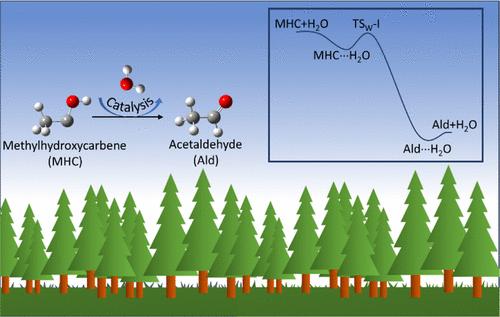对流层中甲基羟基碳氢化合物的命运以及单个水分子有效促进其异构化为乙醛的能力
IF 15.6
1区 化学
Q1 CHEMISTRY, MULTIDISCIPLINARY
引用次数: 0
摘要
丙酮酸通过吸收太阳光化通量的紫外线(UV)光解作用在大气中产生甲基羟基碳(MHC)。人们认识到,分离的MHC可以进行单分子异构化,形成乙醛和乙烯醇。然而,其与大气组分可能发生的双分子反应的速率和机理尚不清楚,这些反应可能与单分子反应同时发生。本文研究了MHC在160 ~ 380 K温度范围内与大气中常见的三种分子N2、O2和H2O反应的热力学、动力学和机理。我们在CCSD(T)/6-311++G(3df,3pd)//M06-2X/6-311++G(3df,3pd)水平上的研究表明,MHC + N2相遇是非反应性的,而MHC + O2反应导致CH3CO + HO2的形成,其速率与先前的估计有显著不同。对于MHC + H2O反应,我们发现单个H2O分子在催化MHC异构化以形成乙醛方面非常有效。对这一反应计算速率的分析表明,它将是对流层乙醛的一个重要来源,乙醛是大气反应中间体的一种主要污染物和前体。我们的发现与目前文献中认为MHC + H2O反应较小的评价形成鲜明对比。此外,在MHC + H2O反应体系中,我们发现由于MHC上OH基团的存在,相对于氢键介导的双氢原子转移机制,在单线态碳烯反应中通常占主导地位的协同插入机制被抑制了。本文章由计算机程序翻译,如有差异,请以英文原文为准。

Tropospheric Fate of Methylhydroxycarbene and the Ability of a Single Water Molecule to Efficiently Promote Its Isomerization into Acetaldehyde
The ultraviolet (UV) photodissociation of pyruvic acid through the absorption of solar actinic flux generates methylhydroxycarbene (MHC) in the atmosphere. It is recognized that isolated MHC can undergo unimolecular isomerization to form acetaldehyde and vinyl alcohol. However, the rates and mechanism for its possible bimolecular reactions with atmospheric constituents, which can occur in parallel with its unimolecular reaction, is not well understood. Here we investigate the energetics, kinetics, and mechanism of the reaction of MHC with three ubiquitous atmospheric molecules N2, O2, and H2O over the 160 K-380 K temperature range. Our study, at the CCSD(T)/6-311++G(3df,3pd)//M06-2X/6-311++G(3df,3pd) level, reveals that the MHC + N2 encounter is nonreactive, while the MHC + O2 reaction, which leads to CH3CO + HO2 formation, has a rate that is significantly different from previous estimates. For the MHC + H2O reaction, we find that a single H2O molecule is very effective in catalyzing the isomerization of MHC to form predominantly acetaldehyde. An analysis of the computed rate for this reaction indicates that it will be an important source of tropospheric acetaldehyde ̵ a major pollutant and precursor for atmospheric reactive intermediates. Our findings are in sharp contrast to current assessments in the literature that the MHC + H2O reaction is minor. Furthermore, in the MHC + H2O reaction system, we find that due to the presence of the OH group on MHC, the concerted insertion mechanism, which is typically dominant in reactions involving singlet carbenes, is suppressed relative to a hydrogen bond mediated double hydrogen atom transfer mechanism.
求助全文
通过发布文献求助,成功后即可免费获取论文全文。
去求助
来源期刊
CiteScore
24.40
自引率
6.00%
发文量
2398
审稿时长
1.6 months
期刊介绍:
The flagship journal of the American Chemical Society, known as the Journal of the American Chemical Society (JACS), has been a prestigious publication since its establishment in 1879. It holds a preeminent position in the field of chemistry and related interdisciplinary sciences. JACS is committed to disseminating cutting-edge research papers, covering a wide range of topics, and encompasses approximately 19,000 pages of Articles, Communications, and Perspectives annually. With a weekly publication frequency, JACS plays a vital role in advancing the field of chemistry by providing essential research.

 求助内容:
求助内容: 应助结果提醒方式:
应助结果提醒方式:


